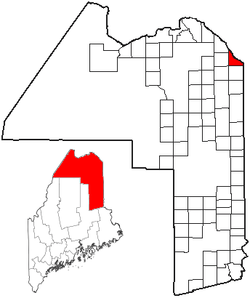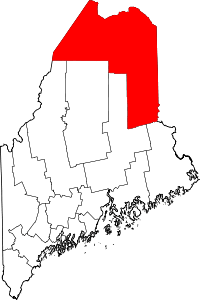Hamlin, Maine
Hamlin is a town in Aroostook County, Maine, United States. It is located on the Canada–US border with a border crossing into Grand Falls, New Brunswick and is the closest continental location to Europe in the United States.[4] The population was 219 at the 2010 census.
Hamlin, Maine | |
|---|---|
 Location of Hamlin, Maine | |
| Coordinates: 47°5′31″N 67°50′55″W | |
| Country | United States |
| State | Maine |
| County | Aroostook |
| Area | |
| • Total | 24.04 sq mi (62.26 km2) |
| • Land | 23.35 sq mi (60.48 km2) |
| • Water | 0.69 sq mi (1.79 km2) |
| Elevation | 659 ft (201 m) |
| Population | |
| • Total | 219 |
| • Estimate (2012[3]) | 216 |
| • Density | 9.4/sq mi (3.6/km2) |
| Time zone | UTC-5 (Eastern (EST)) |
| • Summer (DST) | UTC-4 (EDT) |
| Area code(s) | 207 |
| FIPS code | 23-30690 |
| GNIS feature ID | 0582506 |
History
Hamlin was named for Vice President Hannibal Hamlin.[5]
Public schools
Hamlin is a member of Maine School Administrative District No. 24, which includes the Van Buren District School, a consolidated K-12 school located in Van Buren, Maine.
Demographics
| Historical population | |||
|---|---|---|---|
| Census | Pop. | %± | |
| 1870 | 558 | — | |
| 1880 | 612 | 9.7% | |
| 1890 | 484 | −20.9% | |
| 1900 | 574 | 18.6% | |
| 1910 | 657 | 14.5% | |
| 1920 | 602 | −8.4% | |
| 1930 | 486 | −19.3% | |
| 1940 | 638 | 31.3% | |
| 1950 | 430 | −32.6% | |
| 1960 | 374 | −13.0% | |
| 1970 | 357 | −4.5% | |
| 1980 | 340 | −4.8% | |
| 1990 | 204 | −40.0% | |
| 2000 | 257 | 26.0% | |
| 2010 | 219 | −14.8% | |
| Est. 2014 | 212 | [6] | −3.2% |
| U.S. Decennial Census[7] | |||
2010 census
As of the census[2] of 2010, there were 219 people, 96 households, and 68 families living in the town. The population density was 9.4 inhabitants per square mile (3.6/km2). There were 124 housing units at an average density of 5.3 per square mile (2.0/km2). The racial makeup of the town was 94.1% White, 0.5% Native American, 3.2% Asian, and 2.3% from two or more races.
There were 96 households, of which 16.7% had children under the age of 18 living with them, 60.4% were married couples living together, 5.2% had a female householder with no husband present, 5.2% had a male householder with no wife present, and 29.2% were non-families. 24.0% of all households were made up of individuals, and 13.6% had someone living alone who was 65 years of age or older. The average household size was 2.19 and the average family size was 2.53.
The median age in the town was 54.8 years. 15.5% of residents were under the age of 18; 4.5% were between the ages of 18 and 24; 15% were from 25 to 44; 32.4% were from 45 to 64; and 32.4% were 65 years of age or older. The gender makeup of the town was 48.9% male and 51.1% female.
2000 census
| Languages (2000) [8] | Percent |
|---|---|
| Spoke French at home | 55.56% |
| Spoke English at home | 44.44% |
As of the census[9] of 2000, there were 257 people, 103 households, and 73 families living in the town. The population density was 11.0 people per square mile (4.3/km2). There were 122 housing units at an average density of 5.2 per square mile (2.0/km2). The racial makeup of the town was 96.11% White, 1.95% Native American, 0.39% Asian, and 1.56% from two or more races.
There were 103 households, out of which 23.3% had children under the age of 18 living with them, 65.0% were married couples living together, 3.9% had a female householder with no husband present, and 28.2% were non-families. 23.3% of all households were made up of individuals, and 7.8% had someone living alone who was 65 years of age or older. The average household size was 2.43 and the average family size was 2.88.
In the town, the population was spread out, with 20.6% under the age of 18, 5.4% from 18 to 24, 26.5% from 25 to 44, 32.3% from 45 to 64, and 15.2% who were 65 years of age or older. The median age was 44 years. For every 100 females, there were 102.4 males. For every 100 females age 18 and over, there were 94.3 males.
The median income for a household in the town was $32,625, and the median income for a family was $34,125. Males had a median income of $33,125 versus $14,688 for females. The per capita income for the town was $13,600. About 9.9% of families and 10.0% of the population were below the poverty line, including 15.1% of those under the age of eighteen and 20.0% of those 65 or over.
References
- "US Gazetteer files 2010". United States Census Bureau. Retrieved 2012-12-16.
- "U.S. Census website". United States Census Bureau. Retrieved 2012-12-16.
- "Population Estimates". United States Census Bureau. Archived from the original on 2013-06-17. Retrieved 2013-07-06.
- "The closest point in the United States to Europe". www.acscdg.com. Archived from the original on 2015-09-18. Retrieved 2015-09-08.
- Gannett, Henry (1905). The Origin of Certain Place Names in the United States. Govt. Print. Off. pp. 148.
- "Annual Estimates of the Resident Population for Incorporated Places: April 1, 2010 to July 1, 2014". Archived from the original on May 23, 2015. Retrieved June 4, 2015.
- "Census of Population and Housing". Census.gov. Retrieved June 4, 2015.
- https://apps.mla.org/map_data_results&state_id=23&place_id=30690&cty_id=3. Missing or empty
|title=(help) - "U.S. Census website". United States Census Bureau. Retrieved 2008-01-31.
